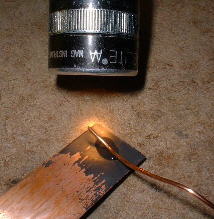

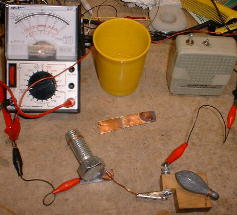
This is a copper oxide photocell and is very simple to make using materials found around the house, yet it seems to serve the purpose as well as similar but more complex homemade photocells that I have read about elsewhere. Although this photocell does not produce enough power to charge batteries or run circuits etc, it can be used for things such as a light sensor or as a pickup to hear a sound modulated light beam. Just imagine the thrill of hearing a sound modulated light beam through a homemade photocell.
To make this photocell, you simply heat a small area on piece of thin copper sheet, red hot in a propane flame, for a minute or so and let it cool. A photocell can now be formed by putting a drop of strong salt solution on the oxidized copper plate and bringing a piece of clean copper wire in contact with the drop. That is all there is to it. The copper wire can be held in place by attaching it to a small block of wood that sits near the copper plate. The plate is one terminal of the cell and the clean copper wire is the other. All pieces of copper that I tried, such as .006 copper sheet from the craft store or a piece of copper tube, worked well.
When this photocell is connected across a volt meter, a small voltage (a few millivolts) will be measured. The copper contact wire on the salt water drop becomes the negative terminal. This voltage can increase 5 to 20 millivolts by just shining a small flashlight on to the drop of salt water. By connecting this homemade photocell to an audio amplifier, audio and even music can be heard from a sound modulated light source.
I prefer the use of analog volt meters over digital ones for this kind of experimentation. The analog meter can give you a much faster feedback and better overall interpretation of what is happening. A digital meter can still serve the purpose well but getting a good feel for what is happening can be difficult when all you see is a bunch of changing numbers.
I have found that it is not necessary to remove the top layer of black oxide as is suggested in other articles. Sometimes these homemade photocells actually work best on the black oxide areas. One big advantage of this drop of salt water method, is that the whole copper plate does not have to be rigorously prepared. One small spot of good oxide on the copper plate is all that is necessary to make a good photocell. Most pieces however, have a large percentage of usable area. Numerous drops of salt water can be placed in various locations on the surface of the oxidized copper plate. The best spots can then be found by touching the copper wire to the different drops of salt water. All pieces of copper that I have heat treated work as a photocell but some are better than others. The challenging aspect is not in making the photocell work, but merely in getting optimum performance from it. One photocell that I made could give a whopping 50 mv increase when the light from a small flashlight was directed on to it.
I usually work under some fluorescent lights which vary in intensity 120 times a second (upper and lower halves of the 60 Hz power waveform). I can also connect the plate and copper wire to an audio amplifier and listen for 120 cycle hum in the amplifier as I touch the copper wire to the different drops of salt water. The best places are easily recognized by the loudest hum. The photocell action can then be verified by blocking the light and hearing the 120 cycle hum diminish or go away completely. The little amplifiers from Radio Shack that fit in the palm of your hand, work well with these homemade photocells.
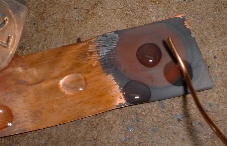
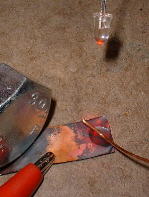

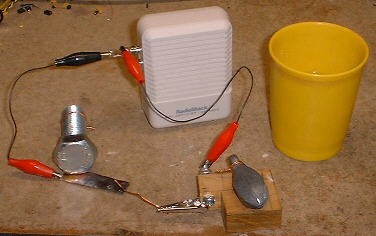
I made some really hot photocells that put out a much louder signal from the sound modulated light, using scrap pieces of silicon. These pieces are some sort of scrap from the semiconductor industry and are available at almost any rock shop or rock show. The only drawback with the silicon is that it is not as fun as using a more common household material such as copper to make a photocell. A metal clamp was placed around the piece of silicon to make contact with it. A drop of salt water was placed on the silicon and a piece of wire was then brought into contact with the drop just as described above.
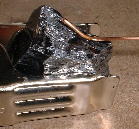
The rough looking pieces of silicon worked best. The smooth polished like silicon pieces didn't work as well unless they were broken in two. After breaking a piece in two, the newly exposed faces would usually make a very good photocell. Almost all of the silicon pieces that I had around worked very well.
The silicon photocell was very peculiar in that I was not able to observe any dc voltage or current from it even though it produced a very much stronger audio signal from the sound modulated light. It acted similar to a normal photocell, that produces dc, but in series with a capacitor. When a flashlight beam is first directed on to the silicon photocell, a positive voltage will rise and then settle to zero while the beam is held in place. When the flashlight beam is later removed, the voltage (that now has settled back to zero) from the silicon cell will drop to a negative value and settle back up to zero.
Using the same drop of salt water method, a plate taken from an old selenium rectifier also worked very well as a photocell pickup for sound modulated light. Unlike the silicon cell, casual observation showed that the selenium photocell, like the copper oxide cell, could produce a steady dc voltage from a steady light source.